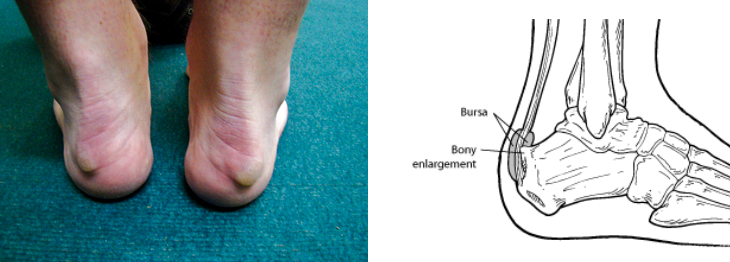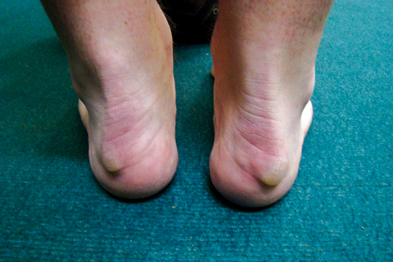
The thing about the foot is that, it is too way down under, it receives all the weight and pressure of the upper body but is often neglected by most people. You might say, “Oh no, I sure take notice of my feet. I buy only fancy shoes for them.” Well, you do indeed, but you do it mostly because you want to cover them and to look beautiful when around with people. There is nothing wrong with being trendy and pretty (or handsome) – no one can deny you have the right to look good.
Yet, here is the thing, keeping up with the latest fashion trends about shoes should not compromise the comfort and health of your feet. You do not want ugly callosities propping up on your feet any time soon because of uncomfortable footwear.
Aside from calluses, another common consequential disorder wrought by wearing ill-fitting shoes is the pump bump. So what is a pump bump? If you feel a hard bulge at the back of your heel and is often painful, then that is a pump bump – medically called as the Haglund’s Deformity.
What makes Haglund’s Deformity painful is that, because there is a bony stuffing on you heel bone, it causes the soft tissue around the Achilles’ tendon to get irritated when it rubs against the shoe. This scenario can result to another ailment called Bursitis, which is the inflammation of the bursa (a sac with fluid located between the bone and tendon).
Why Pump Bump Happens
 Any shoe or footwear that has a rigid back inside can cause pump bump. The rubbing effect it does to the back of your heel triggers the bone to compensate with the pressure by growing a bump. Example of such shoes are women’s pumps (high heels), men’s formal shoes, ice skates, and roller skates.
Any shoe or footwear that has a rigid back inside can cause pump bump. The rubbing effect it does to the back of your heel triggers the bone to compensate with the pressure by growing a bump. Example of such shoes are women’s pumps (high heels), men’s formal shoes, ice skates, and roller skates.
Albeit shoes are often the usual “suspects” on why pumb bump happens, hereditary factors and family history should also be considered in the development of Haglund’s Deformity. Hereditary conditions and certain foot structures can aggravate the progression of pump bumps:
- Feet with high arches
- Tight Achilles’ tendon
- Over-supinated foot (a foot that rolls too much on the outside when walking or running) – the opposite of the condition called overpronation.
How to Deal with a Pump Bump
 The best person to consult with if you want to get rid of that painful pump bump on your foot is the podiatrist. The podiatrist or podiatry specialist is a medical professional who specialises on foot health and lower limb conditions.
The best person to consult with if you want to get rid of that painful pump bump on your foot is the podiatrist. The podiatrist or podiatry specialist is a medical professional who specialises on foot health and lower limb conditions.
After examining your foot, the podiatrist may (or may not) request you to have it undergo an X-ray so he or she can make sure a proper diagnosis will be identified. Once the evaluation has been done thoroughly, he or she will have you go through any (or combinations) of the following non-invasive treatments:
- Ice application – to lessen the soreness
- Full rest – to prevent exacerbation of symptoms
- Anti-inflammatory medication – to relieve pain
- Heel lifts and pads – to cushion the pressure on the heel, especially for high-arched foot
- Change of footwear, particularly recommended are the ones with loose, soft, or no backs – to avoid further irritation of the heel
- Prescribed exercise, such as stretching – to ameliorate the tightness of the Achilles’ tendon
- Ultrasound therapy – as it is proven to provide remedy to the inflammation of the bursa
- Custom orthotics – to support the arches and control the motion of the foot.
In a more serious case of Haglund’s Deformity, the aforementioned treatments may not be sufficient to supply rectification. In such a scenario, the podiatrist may recommend a surgical solution.
As an Advice…
Seeking an early diagnosis and treatment from a competent podiatrist upon the initial onslaught of a bump on one of your heels can prevent a progression of Haglund’s Deformity. For adults and children, 5 years of age and up, it is a good practice to have a yearly foot check with your local podiatrist to address any foot disorder, such as a pump bump, early on.
References:
Champlin, M. BSc Pod., M.Ch.S., S.R., Ch. “Pumb Bump.” Dubai Podiatry Centre. Retrieved from www.dubaipodiatry.com
“Surgery for Haglund’s deformity.” Royal Berkshire NHS. Retrieved from www.royalberkshire.nhs.uk
Johnson, S. and Reed-Guy, L. (17 November 2013; reviewed by Kim, Steven M.D.) “Haglund’s Deformity.” Healthline. Retrieved from www.healthline.com
Image 1 from GPonline.com
Image 2 c/o RoyalBerkshire.NHS.uk

Leave a Comment
You must be logged in to post a comment.